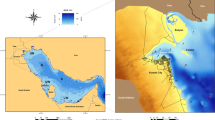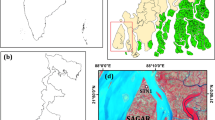Abstract
An interdisciplinary comprehensive survey was conducted in middle and late June 2003 with the Multi-Parameter Environmental Monitoring System YSI6600 and water sample analysis in the sea off the Changjiang River mouth. The Changjiang diluted water (CDW) extended offshore with a bimodal structure during the observation, one extending toward the southeast, the other toward the northeast. The main axis of the CDW extended toward the northeast. A severe red tide with wide spatial extent and brown water color happened. Chlorophyll-a (Chl-a) distribution near the Changjiang River mouth also presented a bimodal structure, and its position and shape were roughly consistent with the extension of the CDW. Water sample analysis indicated that the serious eutrophication produced by the huge amount of nutrient load via the Changjiang River was the main cause of red tide bloom. The dominant algal specie at the most measurement stations wasskeletonema costatum. There existed three centers of higher Chl-a concentration, locating at (122.45 °E, 31.5 °N), (122.4 °E, 30.8 °N) and (123.25 °E, 30.0 °N), respectively. The red tide at (122.45 °E, 31.5 °N) was located in the major modal of CDW and higher turbid seawater, its dominant algal specie wasprorocentrum dentatum with density 2.23 × 106 ind/L. The red tide at (122.4 °E, 30.8 °N) was located in the second modal of CDW and lower turbid seawater, its dominant algal specie wasskeletonema costatum with density 1.0 × 107 ind/L. The dominant algal specie at (123.25 °E, 30.0 °N) wasHeterocapsa circularisquama horiguchi with density 2.0 × 106 ind/L, which was found for the first time forming red tide in the sea off the Changjiang River mouth.
Similar content being viewed by others
References
Chen, Y., Shi, M. L., Zhao, Y. G. et al., The Ecological and Environmental Atlas of the Three Gorges of the Changjiang (in Chinese), Beijing: Science Press, 1989, 157.
Shen, Z. L., Lu, J. P., Liu, X. J. et al., Distribution feature of nutrient in the Changjiang estuary and impact of the three Gorges Dam on it, Studia Marina Sinica (in Chinese), 1992, 33: 107–129.
Wu, Y. L., Fu, Y. N., Zhang, Y. S. et al., Phytoplankton distribution and its relation to the runoff in the Changjiang (Yangtze) Estuary, Oceanologia et Limnologia Sinica (in Chinese), 2004, 35(3): 246–251.
Wang, M. Y., Zhao, Z. J., Zhang, S., Study on the transport of carbon, nitrogen, phosphorus and sulfur in the Changjiang River, Study on the Background Value of Chemical Elements (in Chinese), Beijing: Survey Press, 1989, 121–131.
Ning, X. R., Shi, J. X., Liu, Z. L., Distribution feature of chlorophyll a and ATP in the sea area near the Changjiang River mouth and off the Zhejiang coast in summer, Acta Oceanologica Sinica (in Chinese), 1986, 8(5): 603–610.
Ning, X. R., Dang, J. L. V., Liu, Z. S. et al., Standing stock and production of phytoplankton in the estuary of the Changjiang (Yangtze River) and the adjacent East China Sea, Mar. Ecol. Prog. Ser., 1988, 49: 141–150.
Han, X. W., Wang, X. L., Sun, X. et al., Nutrient distribution and its relationship with occurrence of red tide in coastal area of East China Sea, Chinese Journal Of Applied Ecology (in Chinese), 2003, 14(7): 1097–1101.
Wang, B. D., Wang, X. L., Zhan, R., Nutrient conditions in the Yellow Sea and the East China Sea, Estuarine, Coastal and Shelf Science, 2003, 58: 127–136.
Huang, B. D., Nutrient distributions and their limitation on phytoplankton in the Yellow Sea and the East China Sea, Chinese Journal of Applied Ecology (in Chinese), 2003, 14(7): 1122–1126.
Wang, B. D., Zhan, G., Zhang, J. Y., Distributions and transportation of nutrients in Changjiang River Estuary and its adjacent sea areas, Acta Oceanologica Sinica (in Chinese), 2002, 24(1): 53–58.
Ning, X. Y., Liu, Z. L., Cai, Y. M., A review on primary production studies for China seas in the past 20 years, Donghai Marine Science (in Chinese), 2000, 18(3): 13–20.
Zhou, W. H., Yuan, X. C., Huo, W. Y. et al., Distribution of chlorophyll a and primary productivity in the adjacent sea area of Changjiang River Estuary, Acta Oceanologica Sinica, 2004, 26(3): 143–150.
Shen, Z. L., Liu, Q., Zhang, S. M., Distribution, variation and removal patterns of inorganic nitrogen in the Changjiang River, Oceanologia et Limnologia Sinica (in Chinese), 2003, 34(4): 355–364.
Shen, Z. L., Liu, Q., Zhang, S. M., Distribution, variation and removal patterns of total nitrogen and organic nitrogen in the Changjiang River, Oceanologia et Limnologia Sinica (in Chinese), 2003, 34(6): 577–785.
Pu, X. M., Wu, L. Y., Zhang, Y. S., Nutrient Limitation of phytoplankton in the Changjiang Estuary, I. Condition of nutrient limitation in autumn, Acta Oceanologica Sinica (in Chinese), 2000, 22(4): 58–66.
Pu, X. M., Wu, L. Y., Zhang, Y. S., Nutrient Limitation of phytoplankton in the Changjiang Estuary, II. Condition of nutrient limitation in spring, Acta Oceanologica Sinica (in Chinese), 2000, 23(3): 58–65.
Zhang, J., Zhang, Z. F., Liu, S. M. et al., Human impacts on the large world rivers: would the Changjiang (Yangtze River) be an illustration? Global Biogeochemical Cycles, 1999, 13: 1099–1105.
Wang, J. H., HAB alga nearby Changjiang Estuary, Marine Environmental Science, 2002, 21(2): 37–41.
Xu, L., Hong, Y. C., Wang, G. L. et al., Phenomenon of red tide at the Changjiang River mouth and adjacent sea, Marine Science Bulletin (in Chinese), 1994, 13(5): 25–29.
Guo, Y. J., Yang, Z. Y., Amount variation of phytoplankton and ecology analyses nearby the Changjiang mouth, Studia Marina Sinica (in Chinese), 1992, 33: 167–169.
Chen, C. S., Zhu, J. R., Beardsley, R.C. et al., Physical-biological sources for dense algal bloom near the Changjiang River, Geophysical Research Letters, 2003, 30(10): 1515–1518.
Zhu, J. R., Shen, H. T., Mechanism of Expansion of the Changjiang Diluted Water, Shanghai: East China Normal University Press, 1997, 18–176.
Beardsley, R. C., Limeburber, R., Yu, H. et al., Discharging of the Changjiang (Yangtze River) into the East China Sea, Continental Shelf Research, 1985, 4(1/2): 57–76.
Zhu, J. R., Dynamic mechanism of the upwelling on the west side of the submerged river valley off the Changjiang mouth in summertime, Chinese Science Bulletin, 2003, 48(24): 2754–2758.
Li, D., Zhang, L., Huang, D. et al., Oxygen depletion off the Changjiang (Yangtze River) Estuary, Science in China, Ser. D, 2002, 45(12): 1137–1146.
Author information
Authors and Affiliations
Corresponding author
About this article
Cite this article
Zhu, J., Wang, J., Shen, H. et al. Observation and analysis of the diluted water and red tide in the sea off the Changjiang River mouth in middle and late June 2003. Chin.Sci.Bull. 50, 240–247 (2005). https://doi.org/10.1007/BF02897534
Received:
Accepted:
Issue Date:
DOI: https://doi.org/10.1007/BF02897534




